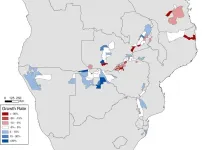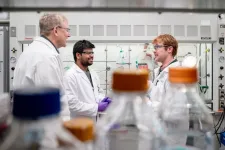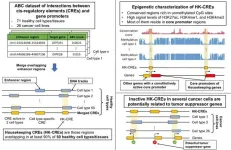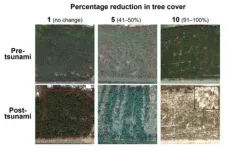(Press-News.org) About three years before he retired, David Campbell noticed something weird happening as he typed. Whenever he tried to hit a letter, say “a,” he’d get “aaa,” like the keyboard was jamming or his finger was triple-tapping the key. That wasn’t the only thing that seemed off—his sense of smell was faltering. “Little things,” he says, “that I didn’t think of as being a big deal.”
A couple of weeks after he retired in fall 2020, Campbell learned the little things weren’t so little—they were life-changing. He was diagnosed with Parkinson’s disease. The repeated “a” was caused by a slight tremor as nerve cells in his brain degenerated or died, interrupting the signals controlling his muscles. A tremor is many patients’ first Parkinson’s symptom, followed by a raft of other steadily worsening neurological issues, such as a quieter voice, slower movement, stiffer limbs, and tighter facial expressions. Almost all patients will suffer some loss of smell too.
Although therapy and medications can bring some relief from the neurodegenerative disorder, there’s no cure. Somewhere between 500,000 and 1 million Americans have Parkinson’s, including actor Michael J. Fox, singer Neil Diamond, and civil rights activist Jesse Jackson.
For Campbell, it was a pretty shabby retirement gift. As he tried to adjust to his new reality, the former Boston University laboratory engineer joined a support group and decided to volunteer for research studies that aimed to improve treatment—perhaps even plot the route to a cure. “I figured, I have the disease,” he says, “I might as well try to do something good with it.”
That decision is already having an impact. With the help of volunteers like Campbell, researchers at Boston University’s Center for Neurorehabilitation, a hub for Parkinson’s research, education, and clinical care, have made two important advances that may help people with the disease walk more smoothly, even turn their shuffled steps into confident strides. In one study, they used wearable soft robotic apparel—a series of fabric wraps, cables, actuators, and sensors—to help patients walk farther and faster. A second study used a music-based technology to increase walking duration and distance—controlling a song’s beats per minute to keep the steps up.
Based at BU Sargent College of Health & Rehabilitation Sciences, the center has been at the forefront of research establishing the benefits of exercise and physical therapy in taming Parkinson’s disease’s impact and improving quality of life. And both of the newly tested therapies could find their way into patients’ everyday lives relatively quickly. The robotic device uses technology that’s already commercially available; the musical intervention uses store-bought headphones. But, says Terry Ellis, the Center for Neurorehabilitation’s director, without the volunteers who give up hours of their time to participate in research studies or help her team test ideas and tweak gadgets, none of it would be possible.
That’s a story told across BU. Volunteers join research studies—as well as classroom discussions and clinical training programs—on a wide range of topics, participating in person or from home. Some even do it over decades, like those who’ve given their time to the long-running Framingham Heart Study and BU’s Black Women’s Health Study.
“Most of our research is intervention studies, so there’s hypothetically some benefit for them,” says Ellis of her center’s work. Their fitness may improve, they may get to try out some symptom-relieving tools. “But without them, we couldn’t do the work. I’m always saying to [volunteers], the work wouldn’t exist without your participation and contribution.”
Robotic Apparel Eliminates Freezing of Gait
Being a research study guinea pig can be rewarding, and might even save or improve lives, but it’s hardly glamorous work. For most of the apparel study, the main volunteer (unnamed in the final paper to protect their privacy) spent his time walking back and forth—again, and again, and again. At first, it was to get a baseline of his walking ability, then to allow the researchers to monitor the robotic tech’s effectiveness at shifting his stride and fine-tune the technology.
The patient, a 73-year-old male who’d been diagnosed with Parkinson’s 10 years earlier, was struggling with a common Parkinson’s problem known as freezing of gait. During a freezing episode, thought to be caused by a malfunction in the brain’s locomotor circuitry, a patient’s stride shortens, their walking speed tumbles, and their muscle coordination falls out of whack. Then they just stop—it reportedly feels like their feet are glued to the floor. Things had gotten so bad for the patient working with Ellis—more than 10 freezing episodes a day, resulting in multiple falls—he’d taken to getting around on a kick scooter.
“It’s just devastating,” says Ellis (CAMED’05), a Sargent professor and chair of physical therapy. “There’s really no medicine or surgery that improves this. It interferes tremendously with people’s everyday life.”
She and her colleagues had tried wearable robotic apparel with people recovering from a stroke—finding it helped some regain their pre-stroke walking speeds—and wondered if similar technology might work for Parkinson’s too. That exosuit, which is now commercially available for stroke rehabilitation from medical device company ReWalk Robotics, was derived from a model developed for the military by Harvard University’s Biodesign Lab to increase service members’ endurance.
In most iterations, the robotic apparel looks like a highly engineered sports brace, using an algorithm to drive motors and cables that strategically apply forces to supplement muscles and joints. The version the researchers tailored for the Parkinson’s study featured two bands: one around the waist, the other around the thigh, each connected by a spooled cable. When activated, the spool turns, retracting the cable and pulling the thigh up. Ellis calls it a mechanical assist: “It provides a little bit of force—it’s perceptible, but at a very low level.” The algorithm helps time the assistance to the users’ steps and tailor the amount of force needed.
As the study progressed, the researchers put their volunteer through his paces with a range of different tasks, including timed walking tests in the lab and outside in the community, adjusting the force provided by the suit—and its timing—and assessing the biomechanics of his walking.
The results were striking: when the suit was on, the volunteer strolled easily down the corridor, arms and legs swinging with a natural confidence; when it was powered down, the change was almost instant—he staggered, stumbled, shuffled, and grabbed at the wall for balance.
When switched on, the robotic apparel eliminated his freezing of gait—the first time any study has shown a potential way to overcome the debilitating symptom. The findings were published in Nature Medicine.
“It’s pretty amazing,” says Ellis, who collaborated with researchers from BU and Harvard University. “We think we’re driving an increase in step length and that’s preventing the shortening of the steps that leads to freezing. In future, we envision you could wear this like underclothes.” Her coauthors include Conor Walsh, a Harvard University professor of engineering and applied sciences; Franchino Porciuncula, a Sargent research scientist; and Jinsoo Kim, a Stanford University postdoctoral scholar and recent Harvard PhD student.
The researchers even did an informal test outside the study, letting the volunteer take the apparel for a spin at home. “And he did pretty well,” says Ellis. “There were certain tight spots where it didn’t work as well as we would want, so we talked about playing with the algorithm to make it work better.”
This was just a small study with one patient, so the next stage would be scaling the project up with more volunteers. But Ellis says because the base technology is already commercially available through ReWalk, there aren’t many barriers to getting the suit into clinics. She pictures a near future where a patient visits a physical therapist, their walking is assessed, and they get robotic apparel tailored for their needs. Even without the tech, the team’s findings on the biomechanics of freezing gait may help therapists better target treatments to combat it.
Walking to the Beat Improves Quality of Life with Parkinson’s
Another volunteer being helped to hit her stride is Ann Greehy. A former school guidance counselor, she was diagnosed with Parkinson’s in 2015 and began volunteering at BU three years later. Her most recent contribution was as a volunteer on a project examining the use of music as a walking aid.
In a new study published in the Journal of Parkinson’s Disease, Ellis and Porciuncula found they could use a song’s beats per minute to help people increase their gait speed and stride length, and cut out variability in their walking patterns. Greehy was one of those who’d helped them assess the technology.
During the study, researchers placed sensors in subjects’ shoes to monitor their gait and gave them an Android device loaded with a music software app. The proprietary system, which uses a technique known as rhythmic auditory stimulation, plays music with beats per minute tailored to a patients’ natural walking cadence, helping them gradually increase their pace session by session; all the participants were asked to plug in their headphones and walk for 30 minutes, five days a week.
“It was amazing when the beats started—it was a whole new experience,” says Greehy. “You put your shoulders back and you’re up walking.”
After four weeks of using the system, which was developed by neurorehab company MedRhythms, the 23 study participants had a similar experience to Greehy. The researchers found that, compared to baseline, they had higher rates of daily moderate intensity walking (up by an average of 21.44 minutes) and more steps (up by 3,384 steps). In the paper, they noted “quality of life, disease severity, walking endurance, and functional mobility were improved after four weeks.”
“People with Parkinson’s can’t move automatically—they have to think about the movement,” says Ellis, who collaborated on the study with researchers from the University of New England, Johns Hopkins University, and MedRhythms. The part of the brain, the basal ganglia, that sends the signals that help people walk without deliberate thought is dysfunctional. “You can’t possibly keep that level of attention to the task of walking, so we were trying to figure out how to provide an external signal if the internal signal is not working.”
The music provided that signal—in the same way your workout playlist gets your feet moving on the gym treadmill. “You’re not thinking, ‘Oh, I want to run to the beat of the music,’” says Ellis. “It just happens, and so it takes a lot less cognitive energy.”
Making Sense of Life with Parkinson’s
One of Greehy’s highlights of the music study was making Ellis’ students laugh by sharing her favorite track: rapper Flo Rida’s “Club Can’t Handle Me.” They were “on the floor laughing at this old lady who likes Flo Rida,” she says. Like Greehy, many of the volunteers also come into BU to work with students, sitting in on classes and panels, talking to them about living with Parkinson’s disease, answering their questions, and giving them a chance to practice their care skills. Some volunteers also attend the Center for Neurorehabilitation as a patient, receiving physical therapy services.
“Our research and clinic are one and the same,” says Ellis. “That chasm that can exist between research and clinical practice doesn’t exist here. The questions we try to answer with research come from our interactions with patients in the clinic—it’s their challenges and problems that they bring to us that make us curious about how to solve them.” And when they find a solution, they take it straight into the clinic.
Another of the music study volunteers and clinic patients, retired psychologist Ed Hattauer, appreciates that focus on making lives better—including his own. “As an old-time PhD researcher, I really relish in the importance of doing research, but research that’s very practically oriented toward helping people do things.” Hattauer says that when he comes to the center, there’s “really a sense of personal caring that gets communicated. And I think what I carry away is a sense of hope. It helps sustain my hope and my feeling of emotional connection.”
Greehy says there are a whole bunch of factors that keep her coming back: “I’ve gotten so much out of this it’s not even funny.” She loves working with students, she gets great tips from the therapists about maintaining her hobbies, like gardening, and she feels good being part of the push for a solution to the disease. Most importantly, volunteering has helped her make sense of life after her diagnosis.
“What are you going to do with this disease?” says Greehy. “Are you just going to sit back or are we going to jump in? I want us to do more to wipe this thing out. I think it’s time.”
Like other volunteers, Greehy knows the disease probably won’t be cured in her lifetime, but it won’t stop her trying.
“I don’t know if they’ll find a cure for me necessarily,” says Campbell, “but I’ve been around research and development my whole life and it feels good to contribute in whatever way possible. I could just sit at home and wallow in pity and do nothing, but it feels proactive to go out and make an effort to advance the science.”
Republishers are kindly reminded to uphold journalistic integrity by providing proper crediting, including a direct link back to the original source URL here.
END
Can we fight back against Parkinson’s disease? These research volunteers hope so
Volunteers at a BU neurorehabilitation center are key to two new Parkinson's treatment breakthroughs: wearable robotics and a music system that help patients walk faster and farther.
2024-01-05
ELSE PRESS RELEASES FROM THIS DATE:
After COP28 “insider” climate activists will become increasingly important, study suggests.
2024-01-05
Climate campaigners will increasingly adopt “insider activist” roles, working to change or challenge their organisations from the inside rather than the outside, a new study says.
Research led by the University of Exeter identifies different types of climate activists. As well as “insiders”, there are others who seek to undermine, or even damage, climate-recalcitrant organisations they are members of in the hope of change.
The study says the growing climate backlash against traditional outside climate activism and rise of corporate “greenwashing” means collaborating or ...
Protected areas for elephants work best if they are connected
2024-01-05
PRETORIA, SOUTH AFRICA – Conservation measures have successfully stopped declines in the African savanna elephant population across southern Africa, but the pattern varies locally, according to a new study.
The evidence suggests that the long-term solution to elephant survival requires not only that areas are protected but that they are also connected to allow populations to stabilize naturally, an international research team says.
Their study, published on January 5th in the peer-reviewed journal Science Advances, collected survey estimates and calculated growth rates for ...
Cult mentality: SLU professor makes monumental discovery in Italy
2024-01-05
Douglas Boin, Ph.D., a professor of history at Saint Louis University, made a major announcement at the annual meeting of the Archeological Institute of America, revealing he and his team discovered an ancient Roman temple that adds significant insights into the social change from pagan gods to Christianity within the Roman Empire.
“We found three walls of a monumental structure that evidence suggests belonged to a Roman temple that dates to Constantine's period,” Boin said. “It dates to the fourth century AD and it would ...
Inhalable sensors could enable early lung cancer detection
2024-01-05
CAMBRIDGE, MA -- Using a new technology developed at MIT, diagnosing lung cancer could become as easy as inhaling nanoparticle sensors and then taking a urine test that reveals whether a tumor is present.
The new diagnostic is based on nanosensors that can be delivered by an inhaler or a nebulizer. If the sensors encounter cancer-linked proteins in the lungs, they produce a signal that accumulates in the urine, where it can be detected with a simple paper test strip.
This approach could potentially replace or supplement the current gold standard for diagnosing lung cancer, low-dose computed tomography (CT). It ...
A new approach can address antibiotic resistance to Mycobacterium abscessus
2024-01-05
(Memphis, Tenn.—January 5, 2024) Scientists at St. Jude Children’s Research Hospital are tackling Mycobacterium abscessus (Mab) antibiotic resistance. This naturally antibiotic-resistant pathogen is becoming more prevalent, highlighting the urgent need for novel therapeutics. To address this, the scientists designed new versions of the drug spectinomycin that overcome efflux, the main mechanism driving resistance. The work was published today in Proceedings of the National Academy of Science.
Mab infections are increasingly found ...
nTIDE December 2023 Jobs Report: People with disabilities maintain strong employment levels through end of year, staying at historic highs
2024-01-05
East Hanover, NJ – January 5, 2023 – Following a historic high in November, slight declines were seen in the employment-to-population ratio and the labor force participation rate in December 2023 for people with and without disabilities. However, numbers still remain near the record levels achieved the previous month, according to today’s National Trends in Disability Employment – semi-monthly update (nTIDE), issued by Kessler Foundation and the University of New Hampshire’s Institute on Disability (UNH-IOD).
Month-to-Month nTIDE Numbers (comparing November 2023 to December 2023)
Based on data from the U.S. Bureau of Labor Statistics (BLS) Jobs ...
New study reveals crucial 'housekeeping' genetic elements and their potent role to fight cancer
2024-01-05
Technological advancements have enabled scientists to comprehensively explore genetic control elements, unraveling the complexities of gene activation mechanisms in our genetic code. New evidence challenges the simplistic view that cis-regulatory elements (CREs) are mere on/off switches for genes, emphasizing their ability to exhibit complex behaviors, such as the simultaneous enhancement of gene activity and initiation of gene transcription, e.g., simultaneous enhancer and promoter activities. These switches aren't only important for the enhancement ...
Mixed forests protect coastal areas from tsunami impacts better than monoculture forests
2024-01-05
Coastal forests in Japan had predominantly been afforested with black pine (Pinus thunbergii), a shade-tolerant tree species that can withstand dry land ecosystems and harsh coastal environments. This afforestation initiative, dating back to the Edo period (1603~1867), aimed to mitigate the deleterious effects of robust winds and sand blowing. Subsequent to the Great East Japan Earthquake in 2011, interest shifted to the potential protective effects of coastal forests in reducing the destructive power of tsunamis.
The Great East Japan Earthquake tsunami damaged a total of 2,800 hectares (ha; 10,000 square meters) of ...
IDOR participated in a study evaluating selpercatinib for the treatment of non-small cell lung cancer
2024-01-05
D'Or Institute for Research and Education (IDOR) played an important role in the phase III LIBRETTO-431 multicenter study, which evaluated the efficacy and safety of selpercatinib compared to control treatment, which consisted of platinum-based chemotherapy associated or not with pembrolizumab (immune checkpoint inhibitor) in non-small cell lung cancer (NSCLC). The research was published in the New England Journal of Medicine (NEJM), one of the most important scientific publications in the medical field, and included Dr. Milena Perez Mak, IDOR researcher and clinical oncologist at ...
Novel compound protects against infection by virus that causes COVID-19, preliminary studies show
2024-01-05
Compounds that obstruct the "landing gear" of a range of harmful viruses can successfully protect against infection by the virus that causes COVID-19, a study published today and led by Dana-Farber Cancer Institute scientists shows. Based on the findings, researchers have launched a human clinical trial of one such compound made by chemically stabilizing a key coronavirus peptide.
If the compound, called a stapled lipopeptide, proves effective as a nasal spray in the trial, it could be the basis for a new drug modality to prevent or treat COVID-19, say the authors of the study, posted online today in the journal Nature ...
LAST 30 PRESS RELEASES:
Why nail-biting, procrastination and other self-sabotaging behaviors are rooted in survival instincts
Regional variations in mechanical properties of porcine leptomeninges
Artificial empathy in therapy and healthcare: advancements in interpersonal interaction technologies
Why some brains switch gears more efficiently than others
UVA’s Jundong Li wins ICDM’S 2025 Tao Li Award for data mining, machine learning
UVA’s low-power, high-performance computer power player Mircea Stan earns National Academy of Inventors fellowship
Not playing by the rules: USU researcher explores filamentous algae dynamics in rivers
Do our body clocks influence our risk of dementia?
Anthropologists offer new evidence of bipedalism in long-debated fossil discovery
Safer receipt paper from wood
Dosage-sensitive genes suggest no whole-genome duplications in ancestral angiosperm
First ancient human herpesvirus genomes document their deep history with humans
Why Some Bacteria Survive Antibiotics and How to Stop Them - New study reveals that bacteria can survive antibiotic treatment through two fundamentally different “shutdown modes”
UCLA study links scar healing to dangerous placenta condition
CHANGE-seq-BE finds off-target changes in the genome from base editors
The Journal of Nuclear Medicine Ahead-of-Print Tip Sheet: January 2, 2026
Delayed or absent first dose of measles, mumps, and rubella vaccination
Trends in US preterm birth rates by household income and race and ethnicity
Study identifies potential biomarker linked to progression and brain inflammation in multiple sclerosis
Many mothers in Norway do not show up for postnatal check-ups
Researchers want to find out why quick clay is so unstable
Superradiant spins show teamwork at the quantum scale
Cleveland Clinic Research links tumor bacteria to immunotherapy resistance in head and neck cancer
First Editorial of 2026: Resisting AI slop
Joint ground- and space-based observations reveal Saturn-mass rogue planet
Inheritable genetic variant offers protection against blood cancer risk and progression
Pigs settled Pacific islands alongside early human voyagers
A Coral reef’s daily pulse reshapes microbes in surrounding waters
EAST Tokamak experiments exceed plasma density limit, offering new approach to fusion ignition
Groundbreaking discovery reveals Africa’s oldest cremation pyre and complex ritual practices
[Press-News.org] Can we fight back against Parkinson’s disease? These research volunteers hope soVolunteers at a BU neurorehabilitation center are key to two new Parkinson's treatment breakthroughs: wearable robotics and a music system that help patients walk faster and farther.






